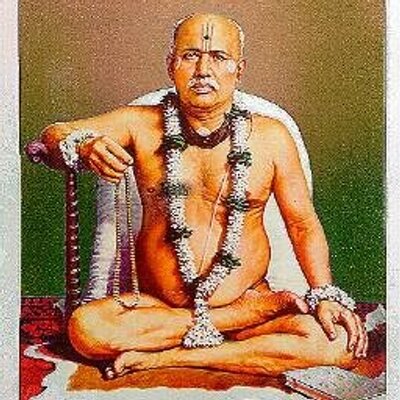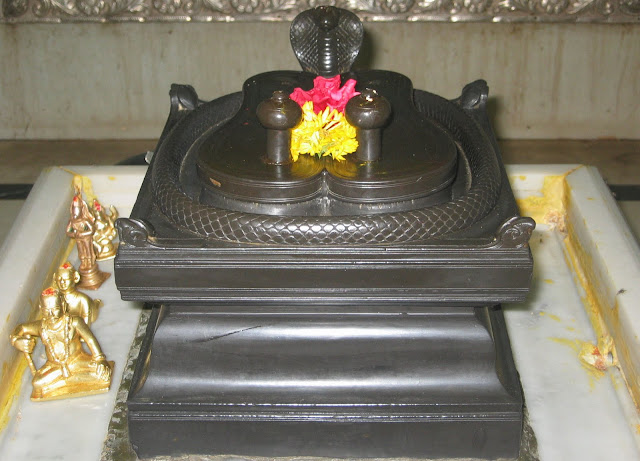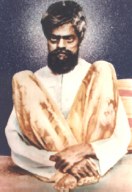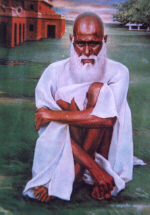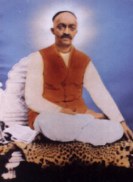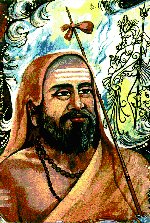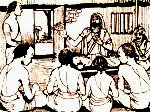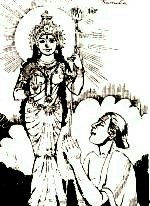POWER OF 'RAM' NAM
GONDAVALEKAR MAHARAJ
YOU HAVE TO REPEAT RAM NAM(NAMA SMARAN)
WITH BHAKTI, AS GIVEN BELOW, CRORES OF TIMES
II SHRI RAM JAYA RAM JAYA JAYA RAM II
|| श्रीराम जय राम जय जय राम ||
FOLLOWING HAVE BECOME SAINTS BY THIS METHOD
1) SAMARTHA RAMDAS - SHIVAJI MAHARAJ'S GURUSAMADHI AT SAJJAN GHAD
2) SRIDHARA SWAMY OF VARADAPURA NEAR SAGAR IN KARNATAKA, HE DID SEVA TO SAMADHI OF SAMARTHA RAMDAS ALONG WITH ABOVE RAM NAM.
3) RAMA OF KANHANGAD,KERALA. HE RECITED ABOVE RAM NAM WITH ॐ (OM) IN THE BEGINNING. HIS ANANDASHRAM IS THERE AT KANHANGAD.HE HAS WRITTEN HIS EXPERIENCES IN A BOOK 'IN THE VISION OF GOD', 'RAMA TALKS' ETC.
4) GONDAVALEKAR MAHARAJ - BRAHMA CHAITHNYA
DETAILS IN THIS POSTING.
IS HE AN INCARNATION OF SAMARTHA RAMDAS ?
SRI BRAHMACHAITHANYA MAHARAJ
SAMADI OF BRAHMACHAITHNYA
Gondavale Maharaj at Kashi, prepared food for fifteen people & fed more than Thousand beggars using his powers.He covered his robe on the rice, Thirth proction(sprinkling) on other dishes.
Even today free lodging, free food is served at Gondavale where his samadhi is there.
When he took his mother to Kashi, he knew that mother won't return(which she didn't know), so he told villagers to take away what ever item they want from their house. The house became empty in half an hour! He told mother she should not have 'HOUSE ATTACHMENT' (GHAR BANDAN) while going to KASHI !
He wanted his Mother to do 'DAAN' to her heart's content, so coins came from under the mat unending(AKSHAY).She asked him how is that coins are not getting exhausted ! He told her not to bother about it !In an ashram at Kashi, his mother had vomiting,motion once or twice & she passed away ! in a matter of few hours.
When he occupied the same room after three years, he told accompanying people that his Mother went to the other world in the same room & asked anybody interested to join her ? One lady obliged & she also passed away in two or three hours, like his Mother !
-- Gondavale Maharaj was married & after his first wife passed away,he married second time a blind girl by birth. His Guru had advised him to lead a life of a house holder.
-- His GURU THUKAMAI was a great saint, Gondavale Maharaj served him very well & passed in all the tests his GURU gave !
-- Every day Bhajans,kirthans and his stories recited in the Prarthana Mandir there. Samadi is at cellar & Prarthana Mandir above it.
When I visited with two of my friends, about Fifty people came out of Prarthana Mandir when Sath Sangh was going on & stood in balcony waving at us & guiding us to Samadhi for no reason !!
-- A very peaceful place & no questions asked.
"My fond desire is that everyone should sincerely take to the practice of Namasmarana" said Brahma Chaithanya.
There was a person who had lived long with Shri Maharaj. About a fortnight before casting off the mortal body, Shri Maharaj said to him, "Commonly the eldest son stays in the company of his father for a great deal of time. Other siblings often stay in distant places, and are in their father's company for a relatively shorter time. Because of the close association with his father, the eldest son is well aware of his likes and dislikes. In such a case, the eldest son has a duty to perform after the death of his father, that is, to further the prestige of the family, he should inform his younger siblings of their father's likes and dislikes and to behave accordingly. "Shri Maharaj further said, "One can not foretell when Death may strike. You are in the know of my likes and dislikes because of our close association. You should tell others about them. If one were to ask about my likings, then I have only one keen liking, and that is that everyone should sincerely observe Namasmarana, and never fail to remember Rama. Do freely tell everyone about this fondness of mine."
I Know You Better Than You Know Yourself
Some one said to Shri Maharaj, " Maharaj, you are clairvoyant. Please tell us how well you know us." To this Shri Maharaj said, "Are you prepared to believe what I will tell you?" The person said "Yes". Shri Maharaj said, " I know more about you than you know about yourself. It is a law of the world that the longer one has been intimately acquainted with something, the more one knows about it. The most intimate acquaintance that you have had is with your body. You are able to know of only that one. But, by the Grace of Shri Rama, all those forms you have put on in your births since the time you acquired the status of a living being, are known to me. From this you can understand how well I know you.
One’s Body is a Pledged Article, And not an Owned OneTradesmen often possess gold in the form of ornaments. When there is need for money for conducting their trade, the tradesmen pledge the ornaments with a bank and obtain money against them. When the amount can be spared, they redeem the ornaments. Someone happened to mention this to Shri Maharaj. Shri Maharaj queried, “What would happen if one were to bring home for use the ornaments so pledged with the bank?” The bank official said, “It would be a crime.” On which Shri Maharaj said, “When God brings some one into this world, he pledges a body with him, and takes a loan symbolized by one’s span of life. As thelife gets spent, day after day, the loan gets repaid. When the span of life comes to its end one day, the body has to be returned to God. If one says that this body belongs to oneself, and acted accordingly, is the behaviour not like bringing pledged ornaments for use at home? Accepting that the body is an article belonging to God, and only pledged to us, we should constantly maintain an awareness of this. Thereby one’s bodily consciousness will automatically vanish. Then, just as the ornaments are returned when the loan has been repaid, and the banker does not feel bad about it, one ought not to feel anything when God takes the body back at the end of the life time. When this stage has been attained, one will have secured mastery over the dread of the final moment.
The Guru Prescribes only such means for realisation of God as one is capable of practising
A highly placed government officer received instruction from Shri Maharaj in chanting Nama, and he sincerely set about practicing it. After some time he learnt about the views of J.Krishnamurthy. Because of their influence, his observance of the practice of chanting Nama became neglected. His mind was filled wih doubts about Namasmarana. He frankly admitted this to Shri Maharaj. Shri Maharaj said, "Krishnamurthy did not invite you to his lecture.You went there of your own accord.So, you can not blame him for having caused confusion in your mind. A rustic boy who, having passed his school final examination, joined the first year class of a metropolitan college. Out of curiosity, on his own he attended a philosophy lecture for the students of the M.A.class. On listening to the lecture, he felt so confused that he doubted if would ever be able to complete his course of studies in the college.The state of your mind has become similar to his. What Krishnamurthy advocates is the path of contemplation, Jnyanamarga. One needs to have read a lot to be able to follow it. So, forget what you have learned from him, and begin the practice of chanting Nama. I guarantee that by chanting Nama, your mind will attain everlasting bliss.I,too, could have preached what was preached by him. But, what is the point in prescribing a lesson which cannot be assimilated?It is for this reason that it was not prescribed for you by me."
Free lodging, free food is served at Gondavale
Gondavale Maharaj at Kashi, prepared food for fifteen people & fed more than Thousand beggars using his powers.Even today free lodging, free food is served at Gondavale
where his samadhi is there.
Biography of Maharaj
NativePlace : Gondavale, Satara, Maharashtra
Period : 1845
Ravji Inamdar, a great pious man lived in Gondavale (Gondavale is a small town with a population of about 6,000, in Satara District in Maharashtra, about 64 kilometres from Satara, on Satara-Pandharpur road.) with his wife Gitabai. They were affluent with ancestral house, farms etc. In spite of this, the couple devoted to God and engaged in donations. People considered the couple Godlike. A son was born to the couple on Wednesday (Hindu Magha month, Shuddha Dwadashi) in 1845. The child was chubby, fair and very beautiful. They named the child as Ganapati, but called him with the nickname as Ganoba. Ganoba was endowed with enormous intelligence. He would learn the Sanskrit slokas by reciting only once. He learnt reading and writing at the age of four. They used to conduct Bhajans every evening and Ganoba would not sleep without participating in the Bhajans. Soon, his Upanayanam was completed. He learnt Sandhyvandanam, worshipping the God. He used to meditate upon the God for hours at stretch. Once at night Ganoba went to a cave near the graveyard and sat there meditating. He was admitted to the school, but he could not concentrate on studies. He used to write "Shri Ram Jaya Ram Jaya Jaya Ram" on the slate. He used to sing bhajans with other children. Sometimes he used to take children far away and worship a stone, as Shri Ram and sing bhajans. Once a Ramdasi (those who follow the path laid down by Samarth Ramdas Swami of Sajjanagad, Maharashtra) had come to Gondavale. He had worn ochre coloured robe. Ganoba asked him why he had worn ochre coloured robe and what he was looking for. Ramdasi told him that he was wandering in search of a Sadguru, who would enable him to meet the God. Ganoba was impressed and then decided to leave his home and go in search of his Sadguru.
He met a pious lady, Radhabai at Haripur, a great devotee Annabua at Miraj, Dev-mamledar at Nasik, Samarth Swami of Akkalkot, Shri Manikprabhu at Humnabad, a yogi from Abu hill, many Tapaswis (those who practice penance) from Naimisharanya, Shri Ramkrishna Paramhansa in Bengal near Calcutta, and finally to Tukaramchaitanya at Yehalegaon near Nanded in Maharashtra. Tukaramchaitanya(called as Tukamai) became Ganoba's spiritual master (Sadguru), whom he served with utmost devotion, sincerity and faith. Tukaramchaitanya tested Ganoba in many ways, but Ganoba never failed his master. After nine months of intense training in the spiritual field, once Tukaramchaitanya took Ganoba in a dense forest on the auspious day of Ramnavmi. Both of them took bath. Tukaramchaitanya said, " My child, I have troubled you really, but you served me wholeheartedly. I have realized that you are truly desirous of meeting the God. I would give all my knowledge of Self to you". Tukaramchaitanya placed his hand on Ganoba's head and instantly Ganoba went into a trance (Samadhi). Tukaramchaitanya named Ganoba as Brahmachaitanya and gave him the 13 lettered gurumantra,
|| श्रीराम जय राम जय जय राम || "Shri Ram Jaya Ram Jaya Jaya Ram" and entrusted the welfare of the people to him. Since then Ganoba became famous as Brahmachaitanya Gondavalekar Maharaj.
Gondavale Maharaj was married & after his first wife passed away,he married second time a blind girl by birth. His Guru had advised him to lead a life of a house holder.
Once, when Maharaj was walking thro' the jungle of Abu, he was held captive by the tribals (Bhils) and taken to their hutments. Tribals were thieves who started to beat Maharaj, but he was not affected. One of them, an old man told others not to beat Maharaj and thought that the latter had some great mystic power (Mantrashakti) with him, which they could gain. Others started to take food there, but Maharaj told he drank only milk. One of the tribals brought a cow that didnot yield any milk and was not tamed, and asked Maharaj to get milk from it. Maharaj went to the cow, patted it with affection and said,"O mother, I am very hungry. Give me milk to satisfy my hunger." And lo! The cow started to yield a lot of milk, which Maharaj drank. When the tribals realized their folly and asked for his forgiveness. Not only Maharaj forgave them but also advised them to renounce the path of thievery and advised them to chant the Ramnam. All of them were completely reformed.
After completing pilgrimage Maharaj settled in Gondavale, where he constructed a temple for Shri Ram and hermitages for the pilgrims. At the very old and ripe age, he took his mother, Gitabai to Varanasi (Kashi) for pilgrimage. Before leaving for Kashi, Maharaj gave away everything from his home as charity to the poor and needy. He took his mother to Kashi and stayed there for one month. At Ayodhya, his mother became unwell. She stopped taking food and medicines and started to chant Ramnam continuously. She bathed in Sharayu river and gave a lot of money in charity. She was surprised that there was an unending source of money below the mattress over which she was made to sit. On the following day, Gitabai left her mortal coil while chanting the Ramnam on her son's lap. After her demise Maharaj said, "Now Shri Ram is my sole refuge". In Indore, he was fed with laddus (sweetmeats) prepared from chili powder, which he happily ate. Later he was fed with red burning embers, which he gladly consumed like sweets. The lady, Jijibai, who did this, repented for her action and asked for his forgiveness.Once, Maharaj was constructing a Ram temple at Gondavale. Many of his disciples brought bricks, stones, cement, timber, and money as an act of devotion to Maharaj. On one Thursday, Maharaj did not have any money to offer to the construction labourers. The labourers were really disappointed, but Maharaj told them not to get disheartened and offered them food. Later he asked them to chant Ramnam. In the evening, one of the disciples of Maharaj came from Mhasavad and offered Rs. 105 to him. Maharaj told the labourers that Ram was always concerned about their problems and distributed the money among them. Though, the temple was being constructed, there was no sign of the idols of Shri Ram, Shri Lakshman and Shri Sitamai. When people asked Maharaj about the idols, he said, " It is Shri Ram's temple, so He would take care of the idols Himself."
Surprisingly, in a nearby village, Talavadegaon, a rich moneylender had brought beautiful idols of Shri Ram, Shri Lakshman and Shri Sitamai for a temple that he wanted to construct. Around this time, his house caught fire and at night, Shri Ram appeared in the dream of the moneylender and asked him to send all the idols to Gondavale to Brahmachaitanya Maharaj. On a Sunday, the moneylender brought the idols to Maharaj when he was singing bhajans of Shri Ram. As soon as he saw the idol, tears of joy started to flow from his eyes. On an auspious day, Maharaj consecrated the idols after the completion of the temple. Thousands of people were offered food on that day. Maharaj loved all the animals equally. He had constructed many Goshalas (cow sheds) at Gondavale. He used to rescue many barren cows that were sold to butchers and bring them and look after them.
Now Maharaj became 68 years old. His body was tired and there was swelling over his feet. Maharaj called his disciples and said," My dear children, please do not forget my Shri Ram. Please take care of yourself. Wherever name of Shri Ram will be chanted, I would be there. Now I am going to leave." Disciples realized that time had come for Maharaj to shed his mortal coil. Thousands of people came from far and wide, offered their salutations to Maharaj and cried. On the Sunday night, Maharaj started to do Bhajan, there were tears in the eyes of all people. Bhajan and Arti were over. Maharaj said, "O Shri Ramchandra, this is my last service to you, please take care of my devotees." Many people offered their obeisance to Maharaj, but Maharaj only touched the heads of his disciples without speaking a word. Maharaj came back to his room. It was 2 a.m. He sat and chanted," Sri Ram, Sri Ram" and closed his eyes, never to open again. The day was December 22, 1913. Many of his disciples had requested him to write a book that could guide them. But Maharaj said, " I have already written 'DasBodh'." Since Dasbodh was written by Samartha Ramdas Swami in 17th century, it is obvious that Brahmachaitanya Maharaj was a reincarnation of the former.



